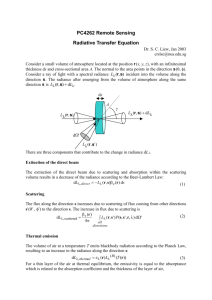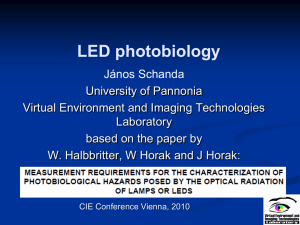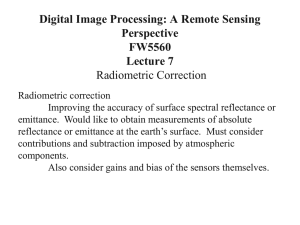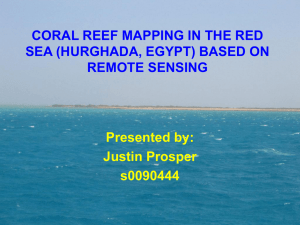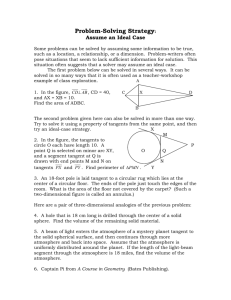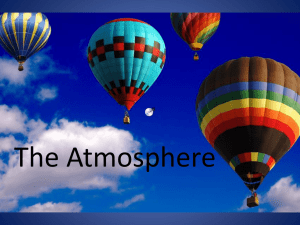PC4262 Remote Sensing - Centre for Remote Imaging, Sensing and
advertisement
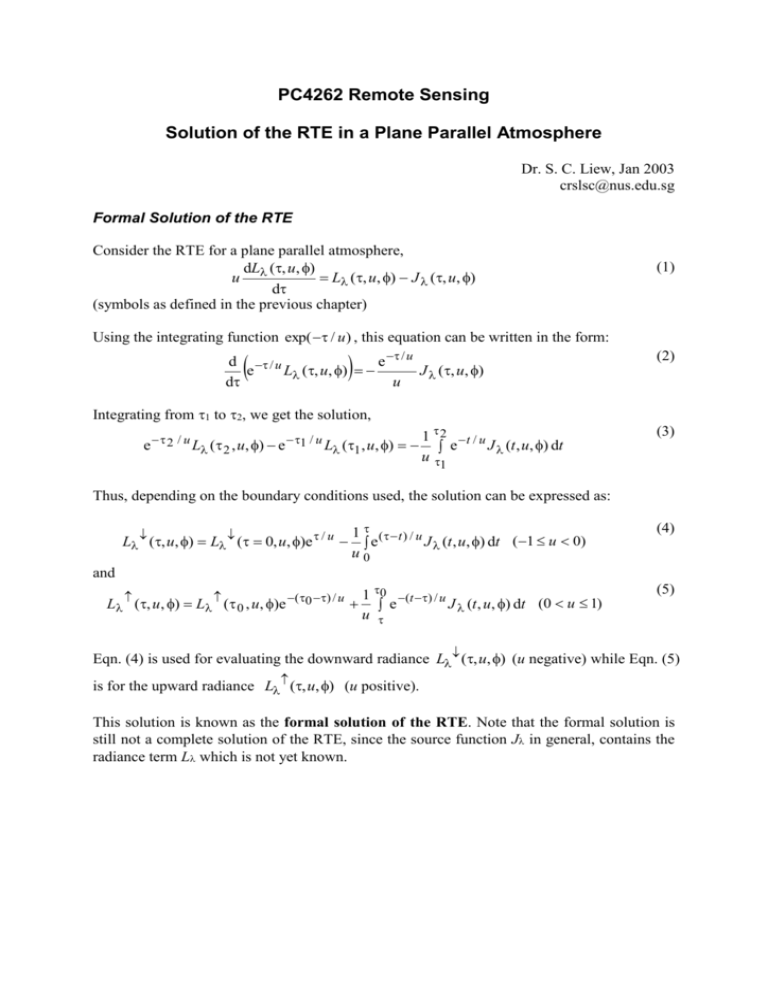
PC4262 Remote Sensing Solution of the RTE in a Plane Parallel Atmosphere Dr. S. C. Liew, Jan 2003 crslsc@nus.edu.sg Formal Solution of the RTE Consider the RTE for a plane parallel atmosphere, dL (, u, ) u L (, u, ) J (, u, ) d (symbols as defined in the previous chapter) (1) Using the integrating function exp( / u ) , this equation can be written in the form: d / u e / u e L (, u, ) J (, u, ) d u (2) Integrating from 1 to 2, we get the solution, e 2 / u L ( 2 , u, ) e 1 / u L (1 , u, ) 1 2 t / u J (t , u, ) dt e u (3) 1 Thus, depending on the boundary conditions used, the solution can be expressed as: L (, u, ) L ( 0, u, )e / u 1 ( t ) / u J (t , u, ) dt (1 u 0) e u0 (4) and L (, u, ) L ( 0 , u, )e (0 ) / u 1 0 (t ) / u J (t , u, ) dt (0 u 1) e u (5) Eqn. (4) is used for evaluating the downward radiance L (, u, ) (u negative) while Eqn. (5) is for the upward radiance L (, u, ) (u positive). This solution is known as the formal solution of the RTE. Note that the formal solution is still not a complete solution of the RTE, since the source function J in general, contains the radiance term L which is not yet known. Thermal Emission in the Atmosphere We now look at a case where only thermal emission is important. For longwave infrared radiation, the scattering coefficient of the atmosphere is negligible, and only absorption is important. The source function is (6) J (, u, ) L B (T ()) We will now find the upward radiance at the top of the atmosphere (e.g. detected by a downward looking thermal sensor on-board a satellite), which can be expressed as (Eqn. 5), (7) 1 0 L (0, u, ) L ( 0 , u, )e 0 / u e t / u L B (T (t )) dt u 0 The first term on the right hand side of this equation is the upward radiance from the ground surface attenuated by the atmosphere, while the second term is due to the emission from the atmosphere itself. The ground surface radiance is the sum of two terms: thermal emission from the surface, and the downward emission from the atmosphere reflected upwards by the surface. We assume that the atmosphere is bounded below by a Lambertian surface at a temperature Ts, with thermal emissivity s(), and hemispherical reflectance s() = 1 - s(). The ground surface upward radiance is, (8) [1 s ()]E ( 0 ) B L ( 0 , u , ) s () L (Ts ) where E ( 0 ) is the downward irradiance at the ground due to atmospheric emission, which can be expressed as (see Eqn. 4) (9) 2 0 0 1 E ( 0 ) e ( 0 t ) / u ' L B (T (t )) u' dt du ' d 0 1 0 u ' 0 0 2 L B (T (t )) e ( 0 t ) / u ' dt du ' 1 0 In the thermal infrared region, the ground emissivity is typically close to one, and hence the surface reflectance is s 0 . The second term in Eqn. (8) can usually be neglected. Hence, the upward radiance at top of atmosphere is B L (0, u, ) s () L (Ts )e 0 / u 1 0 t / u B e L (T (t )) dt u 0 (10) The transmission from a height z to the top of atmosphere along a path inclined at u = cos to the zenith direction is defined as (11) ( z, u ) e ( z ) / u where (z) is the optical thickness from the height z to the top of atmosphere. In differential form, (12) ud d Eqn. (10) can be rewritten in terms of the transmission, (13) d( z, u ) L ( z , u, ) s () L B (Ts )( z 0, u ) L B (T ( z )) dz dz 0 The derivative of transmission with respect to z is the instrumental weighting function for the sensor used in measuring the upward radiance, (14) d( z , u ) W ( z, u ) dz Hence, (15) L ( z , u, ) s () L B (Ts )( z 0, u ) L B (T ( z ))W ( z, u ) dz 0 The atmospheric pressure decreases monotonically with the height z above the ground. Since pressure is a more easily measured quantity than the altitude, it is often more convenient to express height in terms of the pressure P(z). The top of atmosphere radiance is expressed as ps (16) B L ( p 0, u, ) s () L (Ts )( p s , u ) L B (T ( p))W ( p, u ) dp 0 where (17) d( p, u ) dp is the rate of change of transmission with respect to pressure, and ps is the atmospheric pressure at ground surface (z = 0). W ( p, u ) We will see in a later chapter that Eqn. (15) can be used to retrieve the temperature profile T ( p) and the amount of water vapour in the atmosphere, given the measurements of the upward radiance at several different wavelength bands corresponding to the water vapour absorption bands. Isothermal Atmosphere We now consider a hypothetical atmosphere where the temperature is constant, independent of the height. For this atmosphere, the upward radiance at the top of atmosphere (Eqn. 15) can be evaluated to get (18) L ( p 0, u, ) s () L B (Ts )( ps , u) L B (Ta )[1 ( ps , u)] Note: If the top of atmosphere radiance is measured in a wavelength band where gaseous absorption is small (i.e. high transmission from surface to top of atmosphere), the surface emission term in Eqn. (11) dominates. On the other hand, if the measurement is made in an absorption band, then the atmospheric emission term dominates. Scattering in an Atmosphere Illuminated by Solar Radiation Sun Sensor z us u Top of atmosphere =0 us s Ground level x We now consider the RTE equation in the shortwave region where scattering is important and thermal emission can be neglected. The illumination source is the solar radiation at the top of atmosphere. Hence, the downward radiance at the top of the atmosphere is (19) L (0, u, ) F, s (u u s )( s ) where F , s is the solar spectral flux density at the top of atmosphere, us is the cosine of the solar zenith angle and s is the solar azimuthal angle. At any level within the atmosphere, the downward radiance (u < 0) is (Eqn. 4) 1 L (, u, ) F, s e / u (u u s )( s ) e ( t ) / u J (t , u, ) dt u0 (20) where the scattering source function is 2 1 J (t , u, ) P(u, ; u ' , ' ) L (t , u ' , ' ) du ' d' 0 1 (21) Note that the first term on the right hand side of the equation (20) is the direct solar radiance attenuated by the column of atmosphere, and the second term is the diffuse radiance due to scattering of the solar flux by the atmosphere. The upward radiance at any level within the atmosphere is (Eqn. 5) L (, u, ) L ( 0 , u, )e ( 0 ) / u 1 0 (t ) / u e J (t , u, ) dt u (22) The upward radiance at the ground L (0 , u, ) is the result of the reflection of the downward irradiance by the ground surface. Assuming a Lambertian surface, the upward radiance leaving the ground is L ( 0 , u, ) E ( 0 ) (23) where is the ground hemispherical reflectance and E ( 0 ) is the downward irradiance at the ground. From Eqn. (20), the downward radiance at the ground level is L ( 0 , u, ) F, s e 0 / u (u u s )( s ) 1 0 ( 0 t ) / u J (t , u, ) dt e u 0 (24) Thus, the downward irradiance is E ( 0 ) F, s u s e 0 / u s (25) 2 0 0 e ( 0 t ) / u J 0 1 0 (t , u , ) dtdud The downward irradiance at the ground consists of two terms, direct and diffused irradiance: (26) E direct F, s u s e 0 / u s (27) 2 0 0 E diffused e ( 0 t ) / u J (t , u, ) dtdud 0 1 0 Hence, the upward radiance at the ground is / u E ( 0 ) F,s u s e 0 s 2 0 0 ( 0 t ) / u ' L ( 0 , u, ) e J (t; u ' , ' ) dt du ' d' 0 1 0 (28) We are particularly interested in finding the upward radiance at the top of atmosphere: 0 e t / u L (0; u, ) e 0 / u L ( 0 ; u, ) J (t; u, ) dt (29) u This upward radiance is the radiance detected by a sensor on-board a satellite. It is the sum of of two terms. The first term is the ground leaving radiance attenuated by the column of atmosphere while the second term is the path radiance, which is due to the radiance scattered by the atmosphere into the sensor, without reaching the ground. 0 Substituting Eq. (28) into Eq. (29), we have () F, s u s (1 / u 1 / u ) E diffuse s L (0; u, ) e 0 F, s u s 0 et / u J (t ; u, ) dt u 0 (30) The apparent top of atmosphere reflectance is then given by L (0; u, ) T path F, s u s (31) where path is due to the path radiance, and T is a transmission factor for the direct solar irradiance and the diffuse irradiance. In remote sensing of the ground or ocean surface, the top-of-atmosphere reflectance TOA is measured by the sensor. However, the actual ground or water surface reflectance is the parameter of interest. The reflectance to be retrieved is given by TOA path (32) T The procedure of retrieving from TOA is known as atmospheric correction. It involves the calculation of the path and the transmission factors for every pixel in the remotely sensed image. Single Scattering Approximation We will now consider only the rays that undergo at most one scattering event in the atmosphere when calculating the radiances. The scattering source function (from Eq. 21) is given by, ) 2 1 (33) J (; u, ) P(u, u ' , ' ; ) L (; u ' , ' ) du ' d 4 0 1 For single scattering events, we can use the incident solar radiance (Eq. 19) in the integrand, () 2 1 / us (34) J (; u, ) F,s (u'u s )(' s ) du' d P(u, u ' , ' ; ) e 4 0 1 which can be integrated to get, F,s e / us () (35) J (; u, ) P(u, u s , s ; ) 4 Downward Radiance Assuming that the phase function and the single scattering albedo is the same at all height in the atmosphere, we can integrate Eq. 24 to get the downward radiance at the ground, L ( 0 ; u, ) e 0 / u s Fs (u u s )( s ) F, s e 0 / u P(u, u s , s 4u (36) ) 0 t (1 / u 1 / u s ) dt e 0 i.e. L ( 0 ; u, ) e 0 / u s F, s (u u s )( s ) F, s u s / u e 0 s e 0 / u P(u, ;u s , s - ) 4 u s u (37) Upward radiance The downward irradiance at the ground is 2 0 0 E ( 0 ) e 0 / us F,s u s e (0 t ) / u J (t; u, ) dt du d 0 1 0 (25) Using the single scattering source function (Eq. 35), we can integrate the diffuse irradiance part of Eq. (25) E diffuse 2 0 0 e ( 0 t ) / u J (t ; u, ) dt du d (38) 0 1 0 F,s 2 0 0 t (1/ u 1/ u ) / u s e 0 P (u , ;u , ) dt du d e s s 4 0 1 F,s 2 uu s 1 e 0 (1/ u 1/ us ) e 0 / u P(u, ;u s , s ) du d 4 0 u s u In general, numerical integration is needed to evaluate the integral in Eq. (38). If << 1, then we can use the approximation, exp(–x) = 1 – x, to get E diffuse F,s 0 2 P(u, ;u s , s ) du d 4 0 (39) If the phase function is approximately isotropic, then the integral of the phase function in Eq. (39) has a value of 2, then we have E diffuse 1 F,s 0 2 (40) The upward radiance at the ground is / u E ( 0 ) F,s u s e 0 s E diffuse L ( 0 , u, ) (41) At the top of atmosphere, the upward radiance is given by 0 e t / u L (0; u, ) e 0 / u L ( 0 ; u, ) (42) J (t; u, ) dt u The ground leaving radiance is given by Eq. (41), and the path radiance will be determined using the single scattering source function. 0 F,s u s e t / u J (t; u, ) dt P(u, ;u s , s ) 1 e 0 (1 / u 1 / us ) u 4(u u s ) 0 0 L, path (43) The apparent top of atmosphere reflectance is given by L (0; u, ) T path F, s u s In the single scattering approximation, in the limit 0 << 1, 0 path P(u, ;u s , s ) 4uu s and 0 T 1 0 u s 2u s (44) (45) (46) Multiple Scattering Multiple scattering effects can be included using the successive order of scattering approximation. In this method, the radiance is evaluated as a series N L (, u, ) L (0) (, u, L (n) (, u, ) (47) n1 where L (0) (, u , is the direct radiance from the sun without undergoing scattering in the atmosphere, and L ( n) (, u , ) is the higher order radiance that has undergone n scattering events. The n-th order scattering source function is evaluated by integrating the (n-1) order radiance. (48) 2 1 ( n 1) J (n) (t , u, ) (t , u ' , ' ) du ' d' P(u, ; u ' , ' ) L 0 1 The n-th order radiance is evaluated by using the n-th order source function in the formal solution of the RTE (Eq. 4 and Eq. 5). Thus, starting from the solution for the zero-th order radiance, the higher order solutions can be successively obtained.
